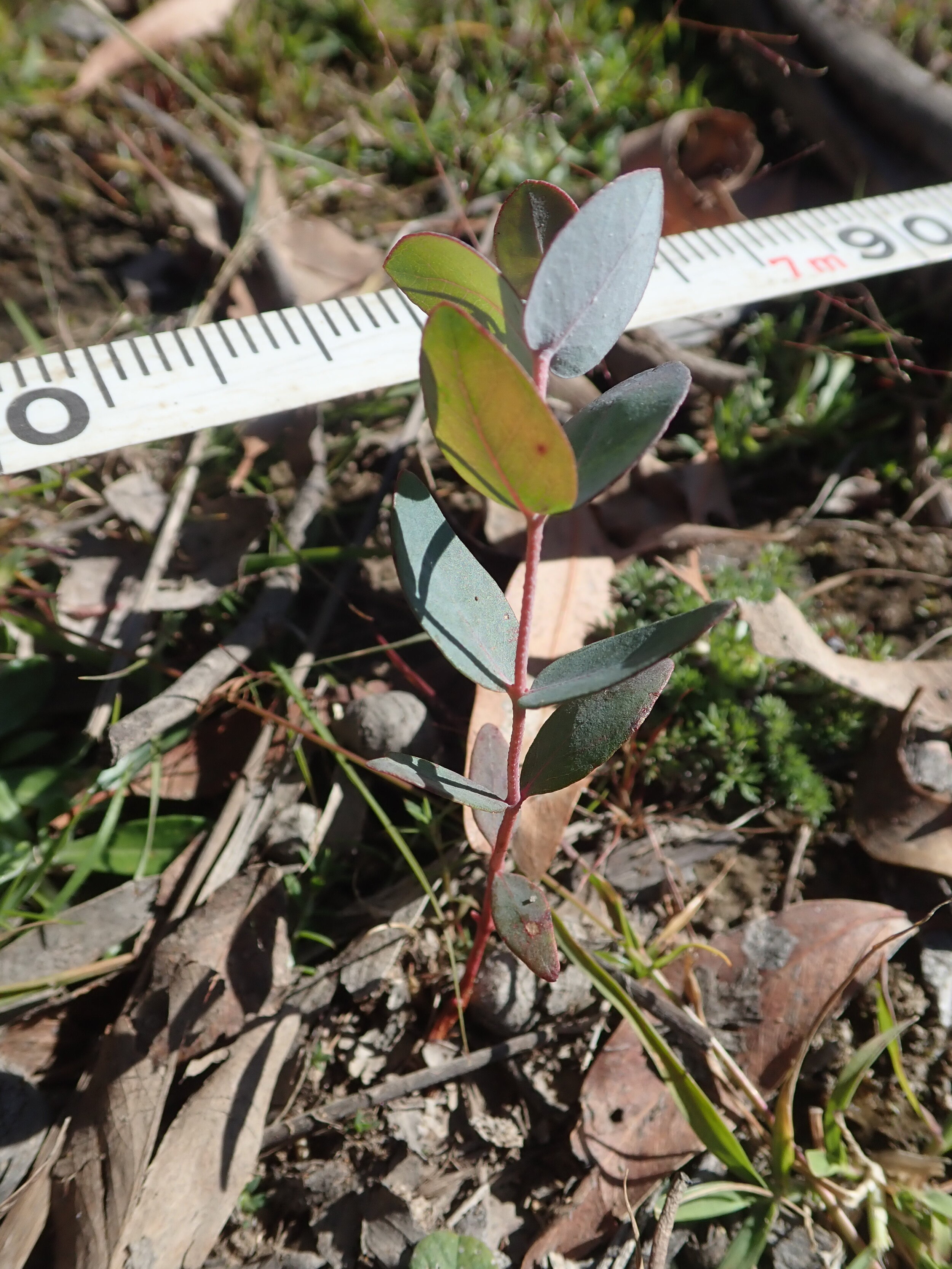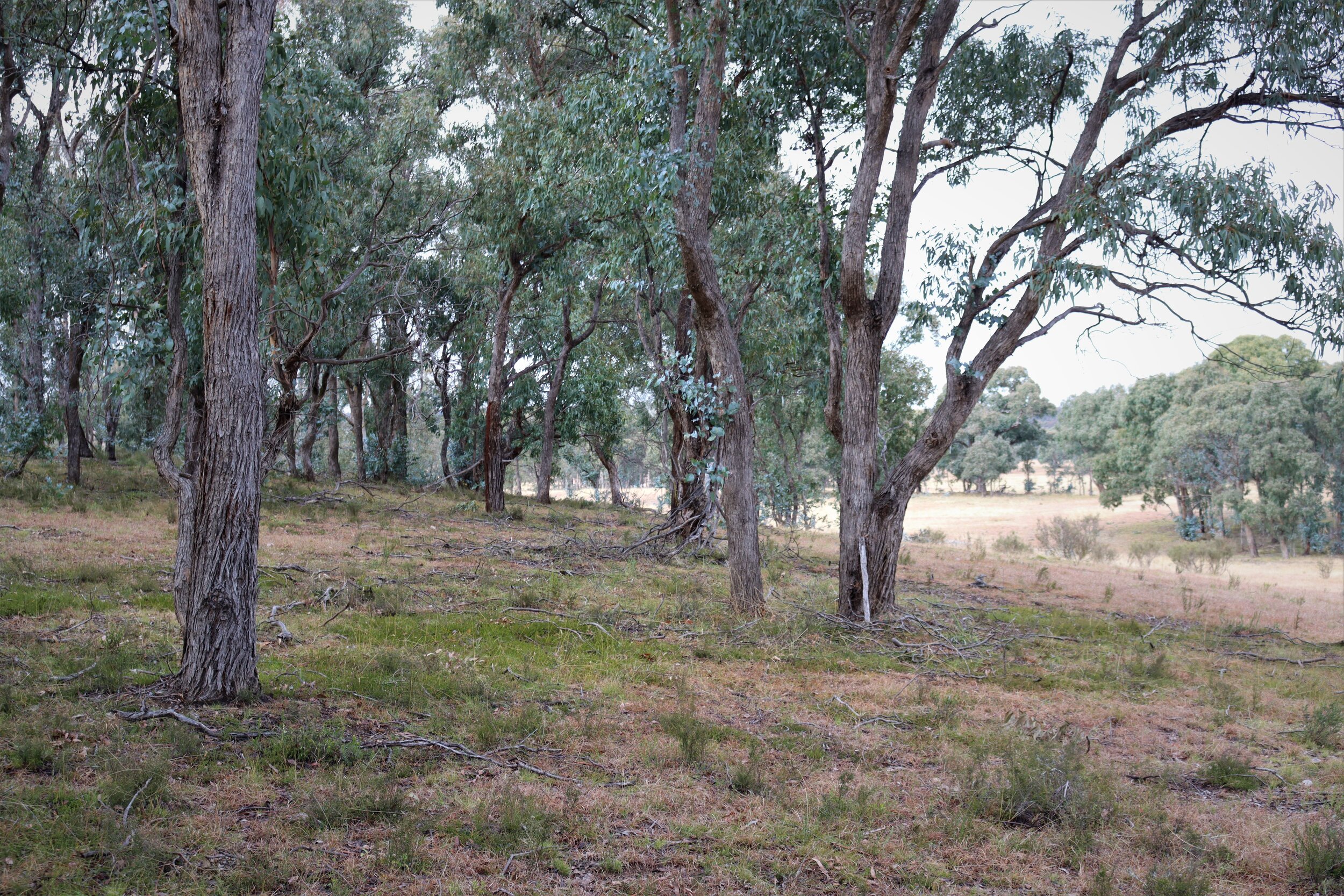New England Peppermint
(Eucalyptus nova-anglica)
Grassy Woodland
Characteristics
Biogeographically restricted to the Northern Tablelands of New South Wales Australia, New-England Peppermint grassy woodland is defined by its dominant overstory species, Eucalyptus nova-anglica, and commonly occurs on a range of geologic substrates including basalt, sediment, and granite (Benson & Ashby, 2020; OEH, 2010). Communities that occur on basalt and sediments are listed as critically endangered ecological communities (TECs) under the biodiversity conservation act of 1999 (OEH, 2010; OEH, 2022). New-England peppermint woodland is distributed throughout the Northern Tablelands bioregion at elevations above 750 m and occupies cold drainage lines, upper riparian areas, and low-lying flats with poorly drained soil profiles of moderate to high fertility (Figure 1). The canopy layer is primarily composed of E. nova-anglica, however, sub-dominant species may also be present, including E. stellulata (Black-sallee), E. pauciflora (White-sallee), and Angophora floribunda (Rough-barked Apple). Stand densities are strongly influenced by soil type, aspect and elevation, and can range from 35 to 50 trees per hectare. New-England Peppermint woodlands naturally have very few mid-story shrubs, but often a diverse understory of grass and herbs.
Figure 1: New England Peppermint (Eucalyptus nova-anglica) distribution showing known and predicted populations across the Northern Tablelands of New South Wales, Australia. Occurrence data was obtained from the Atlas of Living Australia, and the Office of Environmental Heritage (ALA, 2022; OEH, 2022)
Figure 2: New England Peppermint Grassy Woodland on basalt geology with dominant Eucalyptus nova-anglica overstory and a mixed native and exotic grassy understory.
The immediate identifying characteristics of E. nova-anglica include their striking and very obvious blue juvenile leaves that present as opposite, sessile, circular to heart-shaped, and covered in a whitish glaucous bloom (Figure 3). Juvenile leaves are most commonly found on young saplings but are also present throughout the canopy of mature adults, either as new growth in warmer months or on epicormic shoots after disturbance events. Adult leaves are dull to glossy green in colour, strongly lanceolate, narrow, and often present a drooping habit at the tips of branchlets (PlantNET, 2022). Bark type can be highly variable in shape and texture between stands of New England Peppermint, largely depending on tree maturity and local growing conditions. Mature adults often present a rough fibrous bark that is dark grey on the lower trunk and upper canopy, but can vary to a boxy reddish-brown bark. The bark of smaller branches is often smooth with some intermittent flaking, the smallest branchlets sometimes appearing with a reddish-brown colouration. New England Peppermint can grow to 25m tall but is more commonly seen at heights of 15 to 20 m. Flowering generally occurs between February and May, with most trees producing patchy and sporadic blooms of creamy-white flowers arranged in umbels of 5 to 7 buds. Small conical to hemispherical-shaped fruits are often visible throughout the year, with the most abundant fruiting trees being closer to waterways and drainage channels. Fruits can be held on the tree for extensive periods of time, ranging anywhere from 6 to 12 months or longer, with seed fall occurring intermittently as the disc and valves begin to brown off/harden in warmer weather. Seed production is strongly dependent on environmental conditions in previous seasons, with good seasons producing 1 to 3 seeds per each of the 3 to 4 valves. Trees are capable of reproducing from a tree DBH (diameter at breast height) of 15 cm, with the majority of adults producing abundant seeds at 40 cm (unpublished data). As is common to all Eucalyptus species, E. nova-anglica develops a lignotuber within the first year or two of growth, allowing the tree to cache resources for withstanding disturbance events such as fire, drought, loss of limbs, grazing, or insect attack.
Figure 3: Identifying morphological characteristics of Eucalyptus nova-anglica.Top left: Maturing fruit. Bottom left: Juvenile leaves. Top right: Immature buds. Bottom right: Mature adult leaf. Center: Bark. Photos Jeremy Bruhl.
Condition & Threats
New-England Peppermint woodland is one of the most heavily impacted vegetation communities on the Northern Tablelands due to its natural distribution favouring fertile grazing country. Where NEP woodlands once spanned the length of the Northern Tablelands, 130 years of grazing and landscape modification have reduced the remaining communities to 10% of their original habitat (Benson & Ashby, 2000; OEH, 2010). Furthermore, the combined effect of agricultural pressures and dramatic fluctuations in seasonal climatic conditions have resulted in a condition known as New-England Dieback syndrome that dramatically reduces tree health and the ability of trees to recruit new saplings (Nadolny, 2008). Dieback is most evident in the crown of susceptible trees, as repeated defoliation from scarab beetles and drought stress reduces crown health and projected foliar cover. The tree often responds by shooting epicormic growth along the stems and trunk, however, if repeated defoliation depletes remaining energy stores this can result in death. The cause of New England Dieback is due to a number of interconnected factors involving woodland structure, seasonal conditions, and exposure of trees to agricultural fertilisers. Dieback is often most extreme after wet years following drought when average rainfall within the previous decade has consistently exceeded the long-term average (unpublished data). Moisture is a critical factor in the emergence of scarab beetles associated with dieback, if conditions are too dry beetles resist emergence, biding their time for wetter years. Typically, this also correlates with an increase in grass biomass that favours the build-up of large beetle populations feeding on the abundant resources. When combining the increase of beetle populations with unfavourable climatic conditions and continued agricultural disturbance, a ‘perfect storm’ eventuates capable of reducing populations and dramatically altering the structure of woodlands.
Figure 4: New England Dieback in Eucalyptus nova-anglica from drought and herbivory in a New England Peppermint Grassy Woodland.
As climate change is predicted to intensify local environmental conditions across Australia, it is increasingly likely that the current threat levels impacting NEP grassy woodlands will in turn increase (CSIRO, 2020; Nadolny, 2008). This presents a considerable challenge for maintaining populations of E. nova-anglica, particularly as the majority of remaining stands are largely dominated by senescing adults in small pockets of isolated individuals. This has warranted the listing of NEP grassy woodlands on basalt or sediment geology as a critically endangered ecological community (TECs) in NSW (DAWE, 2011; OEH, 2010). The University of New England is currently working on a number of research projects that aim to conserve populations and better understand the ways in which populations are likely to respond to a changing climate. Due to the majority of remaining populations occupying private lands, local landholders have a unique opportunity to play a pivotal role in conserving this unique and quintessential New-England tree. To learn more about how you can contribute, see our techniques and resources sections.
Key features
NEP grassy woodland is biogeographically isolated to the New England Tablelands of NSW
Eucalyptus nova-anglica has been heavily impacted by New England Dieback syndrome
E. nova-anglica can tolerate heavy frosts and cold conditions
NEP grassy woodland is often located in lower slopes within drainage channels or adjacent to waterways on fertile, deep soil substrates
Commonly occurs with Snow-gum (E. pauciflora) and Black-sally (E. stellulata)
Has very little mid-story structure, but a rich understory of grasses and herbs
Stand densities range from 35 to 50 trees per hectare
Flowering occurs between February and May, with fruit held in the canopy for 6 to 12 months or more.
Produces nectar for bees and is a known food source for koalas.
References
Atlas of Living Australia (ALA) (2022). Occurrence download at https://biocache.ala.org.au/occurrences/search?q=lsid%3Ahttps%3A%2F%2Fid.biodiversity.org.au%2Fnode%2Fapni%2F2914144&qualityProfile=ALA accessed on 17 June 2022.
Benson, J.S. & Ashby, E.M. (2000) Vegetation of the Guyra 1:100 000 map sheet New England Bioregion, New South Wales. Cunninghamia 6(3): 747-872
CSIRO, (2020). Climate change in Australia. Retrieved from: https://www.csiro.au/en/research/environmental-impacts/climate-change/climate-change-information accessed on 17 June 2022.
DAWE. (2011) Department of Agriculture, Water, and the Environment: New England Peppermint (Eucalyptus nova-anglica) grassy woodlands EPBC Act Listing. Retrieved from: https://www.environment.gov.au/cgi-bin/sprat/public/publicshowcommunity.pl?id=83
Nadolny, C. (2008). Eucalypt dieback: an increasing threat in rural landscapes?. Australasian Plant Conservation: Journal of the Australian Network for Plant Conservation, 16(4), 26-27.
OEH. (2010). Threatened Ecological Community - New England Peppermint (Eucalyptus nova-anglica) guide booklet. Retrieved from: https://www.environment.nsw.gov.au/resources/pnf/10519NewEnglandPeppermintGuidelines.pdf
OEH. (2022). New England Peppermint (Eucalyptus nova-anglica) Woodland on Basalts and Sediments in the New England Tableland Bioregion – profile. Retrieved from: https://www.environment.nsw.gov.au/threatenedSpeciesApp/profile.aspx?id=10558
PlantNET. (2022). Eucalyptus nova-anglica, Royal Botanic Gardens and Domain Trust, Sydney. https://plantnet.rbgsyd.nsw.gov.au/cgi-bin/NSWfl.pl?page=nswfl&lvl=sp&name=Eucalyptus~nova-anglica
Unpublished data. (2022). Community population demographics of New England Peppermint woodlands on the Northern Tablelands NSW. University of New England.
New England Peppermint (Eucalyptus nova-anglica) seedling
New England Peppermint (Eucalyptus nova-anglica) seedling and adult
New England Peppermint (Eucalyptus nova-anglica) woodland edge
New England Peppermint (Eucalyptus nova-anglica) juvenile leaves
New England Peppermint (Eucalyptus nova-anglica) resprouting adults following drought and insect attack





